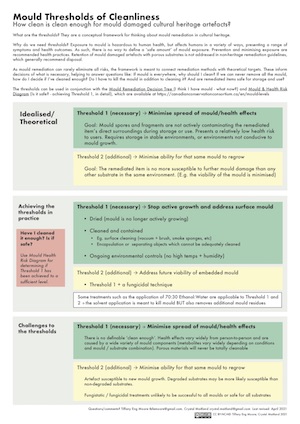Conceptual tools to help decide “how clean is clean enough?” in cultural heritage
The following downloadable PDFs are created by Tiffany Eng Moore and Crystal Maitland as part of their ongoing research in mould remediation for cultural heritage settings. These conceptual tools are designed to help conservators and heritage specialists think about remediation projects in a practical and pragmatic manner. They are meant to assist thinking about mould remediation in cultural heritage, but do not replace advice from health specialists or biologists.
We welcome any feedback, including from those who use it in their own work. The authors can be contacted directly via their email addresses (noted in the PDFs). Two talks on the subject of mould remediation were presented at the ICON Conservation: Together at Home webinar series (2020) and the 46th Annual CAC-ACCR Conference (2021).
Why use these tools?
Exposure to mould is hazardous to human health, but affects humans in a variety of ways, presenting a range of symptoms and health outcomes. As such, there is no way to define a ‘safe amount’ of mould exposure. Prevention and minimising exposure are recommended health practices. Retention of mould damaged artefacts with porous substrates is not addressed in non-heritage remediation guidelines, which generally recommend disposal.
As mould remediation can rarely eliminate all risks, the threshold framework and tools are meant to connect remediation methods with theoretical targets. These inform decisions of what is necessary, helping to answer questions like: If mould is everywhere, why should I clean? If we can never remove all the mould, how do I decide if I’ve cleaned enough? Do I have to kill the mould in addition to cleaning it? And are remediated items safe for storage and use?
The thresholds can be used in conjunction with the Mould remediation decision tree (I think I have mould – what now?) and Mould & health risk diagram (Is it safe? – achieving Threshold 1, in detail), which are all available to download below.
View and download tools
Printing: The documents can be printed on typical US Letter/11 x 17″ or A4/A3. Select ‘Fit to Page’ on printer set up.
Mould thresholds of cleanliness
A framework for what’s essential to mould remediation in cultural heritage. The framework separates remediation into two categories, or thresholds to aim for. This provides the basis for the other two tools.
Mould & health risk diagram
Based off of other risk assessment style charts, the Mould & Health Risk Diagram is used for for mapping scenarios for access to mould damaged or mould remediated artefacts. Its main purpose is to help conservators find instances where mould remediation feels ‘clean enough’ and to note areas where ambiguities about the level of risk about may require extra precautions during use.
Mould remediation decision tree
A tool meant for approaching remediation projects in a practical manner. The most pertinent steps in the process are picked out. Pause points are indicated. Links to other helpful texts are indicated.
..For more information on mould, see our mould resources page here.



